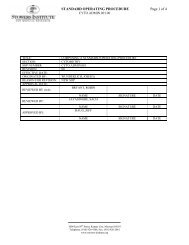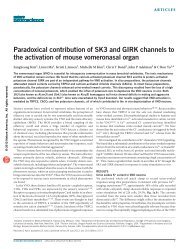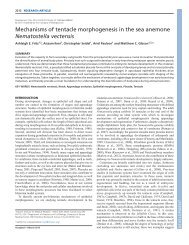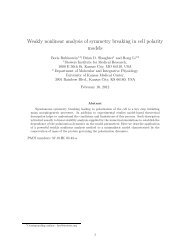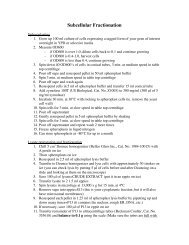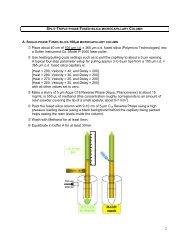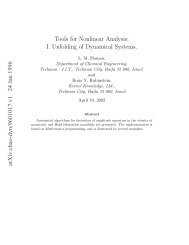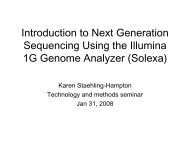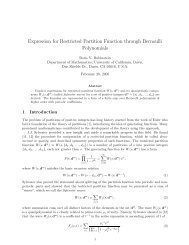Computer Tools for Bifurcation Analysis: General Approach with
Computer Tools for Bifurcation Analysis: General Approach with
Computer Tools for Bifurcation Analysis: General Approach with
Create successful ePaper yourself
Turn your PDF publications into a flip-book with our unique Google optimized e-Paper software.
1004 L. M. Pismen & B. Y. Rubinstein<br />
The normal <strong>for</strong>ms <strong>for</strong> the amplitude a 1 is given by (54) <strong>with</strong> additional resonant terms:<br />
∂ 1 a 1 = c 2, 1, 1<br />
c 2, 2<br />
(ik 1 ∇ 1 )a 1 + c 2, 4(R 1 )<br />
c 2, 2<br />
a 1 + c 2, 3<br />
c 2, 2<br />
a ∗ 2 a∗ 3 ,<br />
∂ 2 a 1 = c 3, 7<br />
c 3, 5<br />
|a 3 | 2 a 1 + c 3, 9<br />
c 3, 5<br />
|a 2 | 2 a 1 + c 3, 11<br />
c 3, 5<br />
|a 1 | 2 a 1 + c 3, 6(R 1 )<br />
c 3, 5<br />
a ∗ 2 a∗ 3 + c 3, 12(R 1 , R 2 )<br />
c 3, 5<br />
a 1<br />
+ c 3, 1, 1<br />
(∇ 1 ∇ 1 )a 1 + c 3, 1, 2<br />
(ik 1 ∇ 1 ) 2 a 1 + c 3, 4, 1(R 1 )<br />
(ik 1 ∇ 1 )a 1 + c (88)<br />
3, 2, 1<br />
a ∗ 2<br />
c 3, 5 c 3,5 c 3, 5 c (ik 1∇ 1 )a ∗ 3<br />
3, 5<br />
− c 3, 2, 2<br />
a ∗ 2<br />
c (ik 3∇ 1 )a ∗ 3 + c 3, 3, 1<br />
a ∗ 3 3, 5 c (ik 1∇ 1 )a ∗ 2 − c 3, 3, 2<br />
a ∗ 3 3, 5 c (ik 2∇ 1 )a ∗ 2 . 3, 5<br />
Below there are <strong>for</strong>mulae <strong>for</strong> the coefficients of<br />
the resonant terms. The quadratic term a ∗ 2 a∗ 3 appearing<br />
in the equation at the first time scale has<br />
the coefficient given by:<br />
c 2, 3 = U † f uu ŨŨ . (89)<br />
The Ginzburg–Landau equation contains three<br />
cubic terms — the self-interaction term does not<br />
change upon the addition of the third wave; two<br />
terms describing interaction of the principal harmonic<br />
<strong>with</strong> the two others have equal coeffcients<br />
c 3, 7 = c 3, 9 given by (66) <strong>with</strong> an additional term:<br />
2(Ũ† f uu UU)(U † f uu R(f u − k 2 D)ŨŨ)/(Ũ† Ũ) .<br />
(90)<br />
There is a quadratic term a ∗ 2 a∗ 3 in the Ginzburg–<br />
Landau equation <strong>for</strong> which the coefficient is given<br />
by:<br />
c 3, 6 (R 1 )=U † f uuR ŨŨR 1 +(U † f uu ŨŨ)(U† R(f u − k 2 D)f uR UR 1 )/(U † U)<br />
+4(Ũ† f uR ŨR 1 )(U † R(f u − k 2 D)f uu ŨŨ)/(Ũ† Ũ) − 3U † f uu ŨR(f u − k 2 D)f uR ŨR 1 . (91)<br />
There are also four differential second-order terms in the equation; their coefficients are given below.<br />
c 3, 2, 1 = c 3, 3, 1 =2(U † f uu ŨŨ)(U† R(f u − k 2 D)DU)/(U † U) − U † DR(f u − k 2 D)f uu ŨŨ , (92)<br />
c 3, 2, 2 = c 3, 3, 2 =4(Ũ† DŨ)(U† R(f u − k 2 D)f uu ŨŨ)/(Ũ† Ũ) − 2U † f uu ŨR(f u − k 2 D)f uR DŨ . (93)<br />
6.1.2. Calculations <strong>for</strong> brusselator model<br />
The calculation of the above coefficients made <strong>with</strong><br />
the help of the function CalculateCoefficient<br />
produces the following results. The coefficient of the<br />
resonant quadratic term in the lower-order equation<br />
is found as:<br />
c 2, 3 = 2d√ d( √ d − a)<br />
√<br />
d + a<br />
.<br />
The modes interaction coefficients are equal to:<br />
d 2<br />
c 3, 7 =c 3, 9 =<br />
a( √ d + a) 3 (d − 1) 2<br />
×(−3a 4 +8a 2 d+6a 4 d+d 2 −20a 2 d 2<br />
−3a 4 d 2 +6d 3 +16a 2 d 3 −3d 4 +2a √ d<br />
×(2a 2 +d−2a 2 d−6d 2 +d 3 )) .<br />
The coefficients of the second-order differential<br />
terms are:<br />
4d 2<br />
c 3, 2, 1 = c 3, 3, 1 =<br />
a( √ d + a) 2 (d − 1)<br />
× (d + a 2 d − a 2 − ad √ d) ,<br />
4d 3<br />
c 3, 2, 2 = c 3, 3, 2 =<br />
a( √ d + a) 2 (1 − d)<br />
× (−1+ad √ d) .<br />
Finally the quadratic term coefficient in the<br />
Ginzburg–Landau equation takes the <strong>for</strong>m:<br />
c 3, 6 (R 1 )=<br />
2d 2√ db 1<br />
a( √ d + a) 3 (d − 1) 2 (2a2 − a 2 d − a 2 d 2<br />
− 3d + √ d(ad 2 +3ad − a)) .




